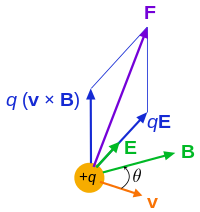The Lorentz force is the force on a point charge due to electromagnetic fields.
If a particle of charge q moves with velocity v in the presence of an electric field E and a magnetic field B, then it will experience a force
![\mathbf{F} = q[\mathbf{E} + (\mathbf{v} \times \mathbf{B})]](http://upload.wikimedia.org/math/b/5/a/b5a66bbfb93e22f6f60240a135dda69f.png)

- ( Lorentz force f on a charged particle (of charge q) in motion (instantaneous velocity v). The E field and B field vary in space and time. )
- Force on a current carrying wireWhen a wire carrying an electrical current is placed in a magnetic field, each of the moving charges, which comprise the current, experiences the Lorentz force, and together they can create a macroscopic force on the wire (sometimes called the Laplace force).By combining the Lorentz force law above with the definition of electrical current, the following equation results, in the case of a straight, stationary wire:where ℓ is a vector whose magnitude is the length of wire, and whose direction is along the wire, aligned with the direction of conventional current flow I.
 (Right-hand rule for a current-carrying wire in a magnetic field B)-----------------------Ref: Wikipedia
(Right-hand rule for a current-carrying wire in a magnetic field B)-----------------------Ref: Wikipedia

No comments:
Post a Comment